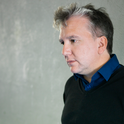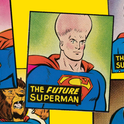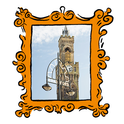Rhyming Life and Death
By Amos Oz, translated by Nicholas De Lange (Chatto & Windus, £12.99)
Amos Oz is a grandfather, both literally and in terms of his status in Israeli literature. He has published 31 books, 19 of which have appeared in English. Born in Jerusalem in 1939, of eastern European parents, he grew up on Amos Street—proof, as if children need such proof, that the world is coextensive with the imagination. He became left-wing during his teens, moved to a kibbutz and changed his surname from Klausner to Oz (which means "strength" in Hebrew). He now lives in Arad, a small desert city, and spends his weekends in the "so ugly it's beautiful" city of Tel Aviv, where this latest novel is set.
Rhyming Life and Death was written a few years ago—although it is set in the early 1980s—and is excellently translated, as usual, by Nicholas De Lange. Whereas most Israeli novels are translated into American English, De Lange is British, and this affects the tone: the third-person narrator comes across as ironic and prone to understatement, the ranginess of his voice less apparent than in the original Hebrew. The novel's protagonist, meanwhile, is identified throughout only as "the Author"—a (moderately) famous writer in his mid-forties, similar but far from identical to Oz. Whereas Oz is deeply connected to Israeli society, both as a public figure and through his family and friends, this fictional Author is detached, striving for connection. It is this provoking tension—the difference, distance and similarities between Israel's grandest and most public man of letters and his isolated, struggling creation—that animates this obliquely autobiographical fiction.
The novel begins with a list of questions: "Why do you write?… Do you constantly cross out and correct or do you write straight out of your head?… Why do you mostly describe the negative side of things?… Do you have another life, one that's not fit for publication?" They're an odd mix of the mundane and the metaphysical; the Author, we gather, will shortly be addressing an audience in a community centre, and these are the kind of queries he most frequently has to fend off. Beforehand, he has a meal at a café: an everyday experience that is soon transformed by his (and his author's) compulsive delight in making up stories. The Author stares at a waitress. Let's say her name is Ricky, he decides; and let's say her ex-lover, Charlie, was once the reserve goalkeeper of the Bnei-Yehuda football team. Now let's say Charlie currently runs a company that manufactures solar water heaters. Then the Author notes a couple of men. They look like lowlife types—so he decides they are a gangster's henchman and a hairdryer salesman, and names them Mr Leon and Shlomo Hougi. The two talk about a third man, who won the lottery and is now in hospital, dying of liver cancer. Duly, the Author's imagination flies off into the cancer ward. And so a first, idle gaze at a waitress expands exponentially through space and time.

What are we to make of this moving, sometimes difficult, often extremely funny and joyfully entertaining, book? Oz himself has pooh-poohed the famous American Jewish authors for writing neurotically obsessed "indoors" novels—yet this is very much an indoors piece, in marked contrast to its immediate predecessor, the sprawling memoir A Tale of Love and Darkness. I was reminded of Philip Roth's Exit Ghost. Roth—who in reality was in reasonable health and enjoying a satisfactory love life—wrote a novel in which his alter ego is dying of prostate cancer and can only fantasise about sex with a young woman. Just so, Oz—a full-time author, happily married—chooses as his hero a twice-divorced accountant who moonlights as an author. Roth and Oz both created sadder versions of their own lives—out of fear, perhaps, of what might develop, or might have developed, or as a charm to ward off failure.
In Israel, the private and the public are interconnected. Even when writing "indoors," Oz's writing is surrounded by the politics that has shaped his life. So, in Rhyming Life and Death, the older characters have experienced the dream of the perfect Zionist homeland becoming the drab reality of getting by. The younger characters are creating the Israel of today. And somewhere in between is the ongoing question of Israel's relationship with Palestinians. At the novel's midpoint, there is a moment when "walking down an unfamiliar back street in the dark the Author collides with some barbed wire that had apparently been stretched across the pavement by children, between a No Parking sign and the rails of a fence." He tears his shirt and bloodies his chest. This symbolic event is as much personal as political, its doubleness impossible to unravel—just as the creative tension between these two forces has long been the mark of Oz's fiction.
Googling Amos Oz, one invariably discovers pages of references to his political views before encountering his fiction. Oz is a pragmatic Zionist—he supports allotting each side a state of its own with a wall between them. Once a supporter of the Labour party (and a veteran of the 1967 and 1973 wars), he now belongs to the peacenik party, Meretz, and is touted by some as one of the leaders of a new left-wing party. The neighbourhood he grew up in has since become ultra-religious. Perhaps partly for this reason, he has no sympathy for religious Jews, or for religious Muslims either. Secular Palestinian nationalism is fine by him; he despises Hamas and Hizbullah, although his position on the recent wars in Lebanon and Gaza was nuanced. Limited warfare in Lebanon, aimed at destroying Iranian-supplied weaponry, was justified, but the prolonged invasion was not. In the case of Gaza, he supported the war initially, to protect Israeli civilians from attacks by Hamas missiles, but felt it should have been carried out so as to reduce the suffering of Arab civilians, and should have ended sooner.
Oz, today, has been succeeded not by one but several generations of Israeli novelists. There are those who go places that he cannot or would not wish to. Sami Michael, for example, tells of the experiences of the Jews of Iraq. Yael Hedaya describes love from a female point of view. Etgar Keret makes up nervy urban fictions, seemingly detached from the news headlines. There are also those who deal with the experience of war directly, as Oz has never done: Haim Sabato, in his semi-autobiographical Adjusting Sights, tells of the Yom Kippur war as perceived by a devout Jewish soldier; Ron Leshem, in Beaufort, evokes the horrors of the first Lebanon war.
Yet Oz's vision—the writing of this grandfather and veteran—remains a vital one for Israel; and the source of both its importance and integrity is shadowed by his anonymous alter-ego in Rhyming Life and Death. "When he was sixteen or seventeen," we are told, "the Author… had an insatiable curiosity to find out why people hurt each other, and themselves, without meaning to at all." This is the abiding theme of Oz's work, and is the reason why he should be read.











